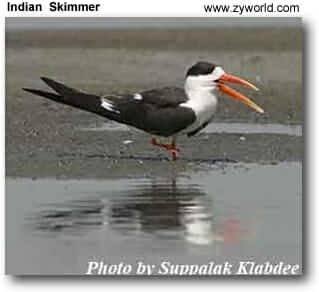Indian Skimmers
The Indian Skimmers (Rynchops albicollis) is a species of bird, one of three members of the skimmer family. It is found in southern Asia where it is patchily distributed and declining in numbers
Description
The Indian Skimmers is 40-43 cm long with a wingspan of 108 cm. It is black above and white below with a white collar and forehead. The wings are long and pointed with a white trailing edge. The short, forked tail is white with blackish central feathers. The long, thick bill is orange with a yellow tip and, like the other skimmers, has a lower beak which is longer than the upper beak. The legs and feet are red.
Non-breeding adults are duller and browner than breeding birds. Juveniles are grey-brown above with pale fringes to the feathers on the back and wings. The head is more white than in adult birds and the bill is orange-brown with a dark tip.
It has a high, nasal, screaming call but is often silent.
The Black Skimmer of the Americas is larger with a black tip to the bill. The African Skimmer is smaller with more black in the tail and no white collar.
Habitat and distribution
It is found on large rivers and lakes, swamps, and coastal wetlands such as estuaries. It is most common in freshwater, particularly during the breeding season. Breeding colonies are on islands or sandy spits, usually in rivers.
Its range has become increasingly fragmented in recent decades. It is still found in parts of Pakistan, northern and central India, Bangladesh, and Burma and formerly occurred in Laos, Cambodia, and Vietnam. It is a scarce non-breeding visitor to Nepal and has occurred as a vagrant in Oman and central Thailand with old records from Iran and China.
Behavior
The birds forage for food by flying low over the water with the bill open and the lower beak skimming through the water. They feed mainly on fish but also take small crustaceans and insect larvae. They often feed at dusk and through the night.
They breed in colonies of up to 40 pairs, often with terns and other birds. The nest is a simple scrape on the ground. The eggs are usually laid between March and May. They are buff or white with brown blotches and streaks. There are three to five eggs in a clutch.
Conservation
The species has a decreasing population of 6,000-10,000 individuals and is classed as Vulnerable by the IUCN. It is threatened by habitat loss and degradation, pollution and disturbance by humans. Most colonies are unprotected but some lie within nature reserves such as National Chambal (Gharial) Wildlife Sanctuary in India.



